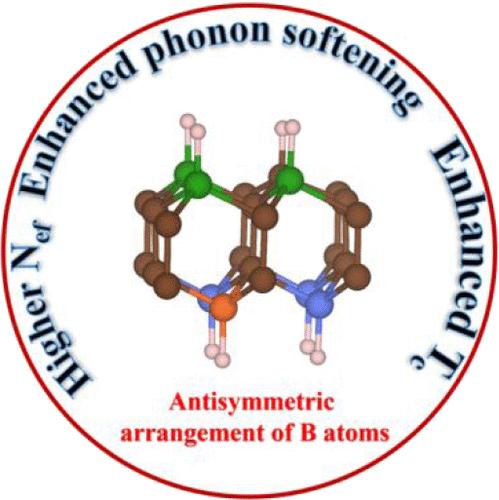不对称硼取代有利于金刚石的超导性
IF 3.2
3区 化学
Q2 CHEMISTRY, PHYSICAL
引用次数: 0
摘要
二维(2D)超导材料对于推进下一代电子产品至关重要。金刚石是一种稳定的二维材料,具有广泛的应用潜力。然而,我们的第一性原理计算表明,金刚石中的硼取代可以诱导高温超导性,显着扩大其在电子领域的潜在应用。通过对不同取代模式──部分取代、单面取代和双面取代──的详细分析,我们发现奇数取代和单面取代产生的超导转变温度最高,可达53.4 K。超导转变温度(Tc)的增加归因于反对称B原子的排列,这增强了态的费米能级密度、声子软化和费米表面嵌套。这些发现为金刚石中高温超导体的设计奠定了理论基础,为二维超导技术的创新应用铺平了道路。本文章由计算机程序翻译,如有差异,请以英文原文为准。

Asymmetric Boron Substitution Favoring Superconductivity in Diamondene
Two-dimensional (2D) superconducting materials are vital for advancing next-generation electronics. Diamondene, a stable 2D material with broad application potential, has traditionally been insulating. However, our first-principles calculations reveal that boron substitution in diamondene can induce high-temperature superconductivity, significantly expanding its potential use in electronics. Through detailed analyses of various substitution patterns─partial, single-side, and double-side─we find that odd-numbered and single-side substitutions yield the highest superconducting transition temperatures, reaching up to 53.4 K. This increase in superconducting transition temperatures (Tc) is attributed to the antisymmetric B atom arrangement, which enhances the Fermi level density of states, phonon softening, and Fermi surface nesting. These insights lay a theoretical foundation for the design of high-Tc superconductors in diamondene, paving the way for innovative applications in 2D superconducting technology.
求助全文
通过发布文献求助,成功后即可免费获取论文全文。
去求助
来源期刊

The Journal of Physical Chemistry C
化学-材料科学:综合
CiteScore
6.50
自引率
8.10%
发文量
2047
审稿时长
1.8 months
期刊介绍:
The Journal of Physical Chemistry A/B/C is devoted to reporting new and original experimental and theoretical basic research of interest to physical chemists, biophysical chemists, and chemical physicists.
 求助内容:
求助内容: 应助结果提醒方式:
应助结果提醒方式:


